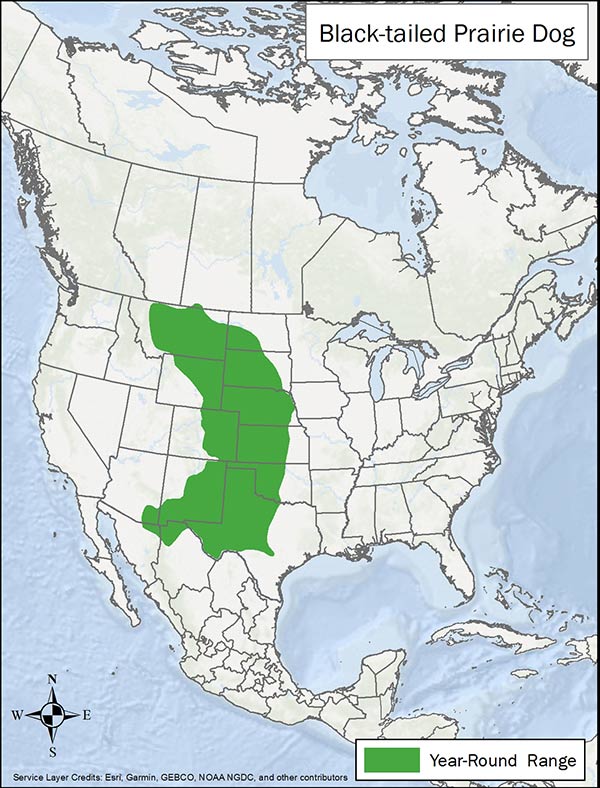LandPKS Learning
Habitat Hub

Black-Tailed Prairie Dog
Black-tailed prairie dog families consist of one male, three or four females, and their pups. Female black-tailed prairie dogs are in estrous for a single day, which is when all breeding takes place. Only about half will wean a litter because of high mortality rates of pups. Males leave their families a year after weaning.
Cynomys ludovicianus
Identification
Black-tailed prairie dogs are stout, burrowing rodents found only in North America. Adults are 14-17 in/35-43 cm long and weigh 1-3 lb/0.5-1.3 kg. Their coat is often brown but varies from black to gray to white with a characteristic, black-tipped tail. Colonies, or “towns”, can be miles wide and support thousands of individual prairie dogs. Black-tailed prairie dog colonies differ from other species of prairie dogs in that they are typically larger (50-150 acres/20-60 hectares) and denser (12-74 individuals per acre/5-30 individuals per hectare). Black-tailed prairie dog range spans throughout much of North America’s western plains, including very southern parts of Canada and very northern parts of Mexico. Population size is estimated currently to be 2% of historical estimates.
Observation Tips
Black-tailed prairie dogs are active during the day and spend time in and outside underground burrows. Individuals can be seen at the openings of burrows, sometimes standing upright. Unlike other species of prairie dogs, they do not hibernate and can be visible year-round. Many colonies are on protected lands. Black-tailed prairie dogs clip grasses short throughout their colonies to see predators. Sylvatic plague can kill more than 99% of prairie dogs in a colony. After a plague event, it will take many years before the colony is recovered, if ever.
Interesting Fact
Black-tailed prairie dog families consist of one male, three or four females, and their pups. Female black-tailed prairie dogs are in estrous for a single day, which is when all breeding takes place. Only about half will wean a litter because of high mortality rates of pups. Males leave their families a year after weaning.
Ideal Habitat
Black-tailed prairie dogs primarily inhabit dry, flat (<10% slope), open grasslands (<20% shrub cover) with low vegetation throughout the Great Plains. Black-tailed prairie dogs will only colonize tallgrass prairie when it has been heavily grazed or mowed. In the more arid, western parts of their range, they inhabit areas dominated by buffalo grass, blue grama, and western wheatgrass. Black-tailed prairie dogs prefer fine to medium textured soil for burrows, and colonies are often found on silty clay loam, sandy clay loam, and loam soils. Depending on the age of the colony and specific location within a colony, there may be a higher percentage of bare ground, forbs and dwarf shrubs than surrounding lands. Older colonies (10+ years) have more forbs and shrubs, while younger colonies have more grasses.

Range map provided by International Union for Conservation of Nature
Management Activities that Benefit Species – Best Management Practices (BMPs)
Where habitat is ideal to support a healthy colony, black-tailed prairie dogs should be allowed to maintain presence on a portion of land, if possible. Collaborating with public land managers can help maintain prairie dog populations while minimizing negative impacts and human-wildlife conflicts. It’s more effective to discourage prairie dogs from colonizing a new area than to eliminate an established colony. Colony expansion can be discouraged by adding visual barriers such as tall, dense vegetation around the area to obstruct their view. Mowing may also assist in colony expansion into an acceptable or desired location. If colony control is necessary, an adaptive management approach that meets goals without eliminating the entire colony or harming other species is recommended. For example, black-footed ferrets, which rely on prairie dogs as food, are being reintroduced in many areas. Contact your local wildlife agency if you are interested in allowing reintroduction of black-footed ferrets. In addition, consider vaccinating prairie dogs against plague or dusting colonies with deltamethrin to control flea populations that carry plague to ensure ferrets have a reliable food source. Federal incentives exist for black-tailed prairie dog colonies on private land.
Management Activities to Avoid
Avoid habitat destruction for agricultural, residential and water developments which can restrict colony size and isolate colonies. Intensive control can result in significant declines or even eradication of small, isolated prairie dog populations. Avoid pesticides that might accidentally kill other species, especially federally endangered black-footed ferrets.
Other Species that Benefit from Similar Habitat Management
Black-tailed prairie dogs are a keystone species and help some grasslands support higher biodiversity. Black-footed ferrets feed almost exclusively on prairie dogs. Bison, pronghorn antelope, mountain plover, horned lark, prairie rattlesnake, badgers, burrowing owl, ferruginous hawk, and swift fox share black-tailed prairie dog habitat. In mixed grass prairie, domestic cattle prefer the forage available on black-tailed prairie dog colony sites over undisturbed prairie.
Download
Download the Black Tailed Prairie Dog factsheet
Other Resources
International Union for Conservation of Nature (IUCN). 2016. The IUCN Red List of Threatened Species. Version 2020-3. Black-tailed prairie dog.
National Park Service. 2015. Prairie Dogs of the American Southwest. Article series.
NatureServe. 2021. NatureServe Explorer: An online encyclopedia of life [web application]. Version 7.1. NatureServe, Arlington, Virginia. Black-tailed prairie dog.
United States Department of Agriculture (USDA). 2007. Fire Effects Information System (FEIS). Cynomys ludovicianus.
United States Fish and Wildlife Service (FWS). 2021. Black-tailed prairie dog.
Mobile App | Data Portal | Knowledge Hub | Habitat Hub | Learning Collections | Blog | About | Contact | Support



